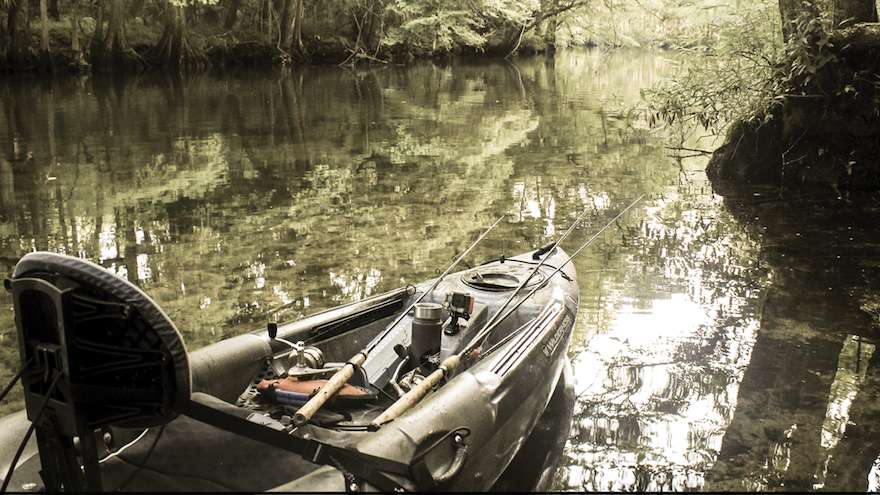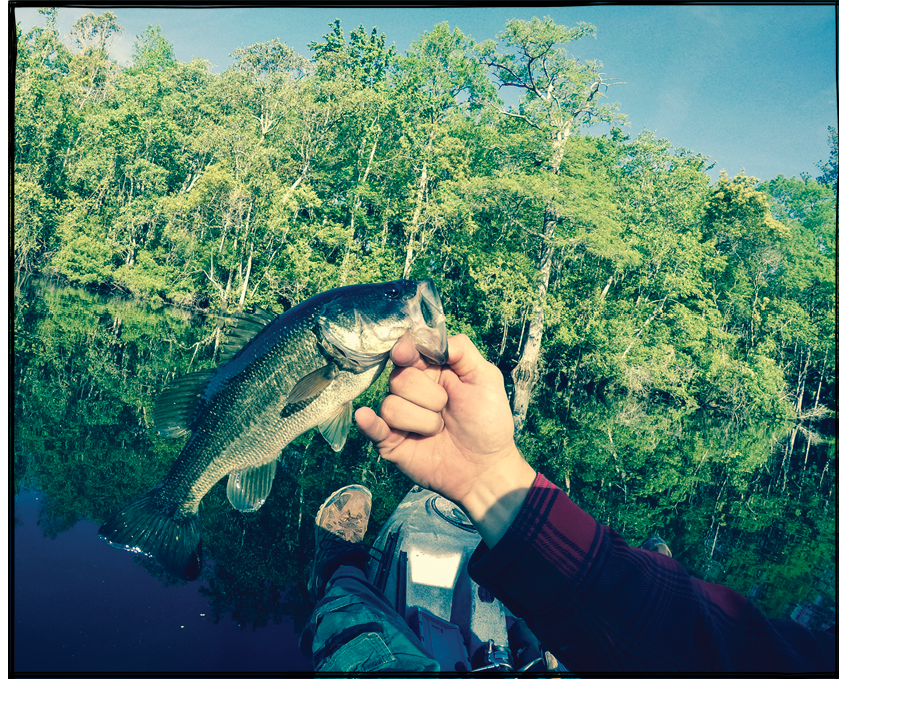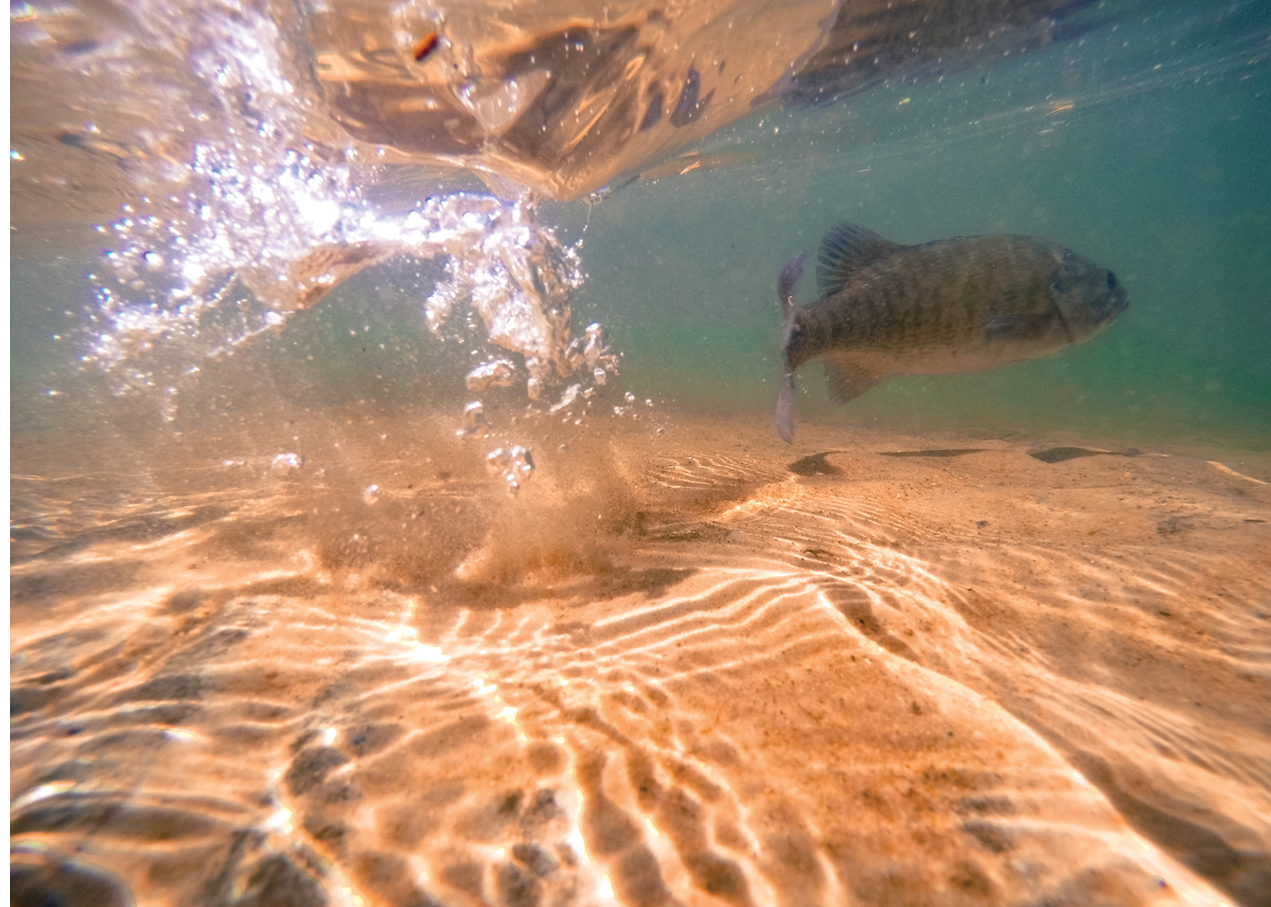
By DH Steinour
Read part 1 here.
Inspired by childhood memories of fishing in Pennsylvania, a soldier looks to the Sunshine State’s small-stream species as salve for his post-deployment scars.
Suwannee bass and largemouth bass
The Suwannee bass sparked my imagination for years. It seems like such a prehistoric fish — a small, scrappy creature perfectly made for jungle creeks, having spent eons in crystal clear isolation. Living in the western panhandle, I didn’t have local options for going after them, but I zeroed in on the Wacissa River on the other side of Tallahassee as being the western-most Suwannee bass locale. I figured on rounding out my Florida bass slam with residual largemouth catches out there.
One morning in early May, I took an exit marked by a roadkill alligator looking like a shredded tire that flew off a monster truck. Imagine hitting a dinosaur like that on the way to the launch ramp. Once I parked at Wacissa Springs, I was immediately in Florida wilderness. It was like a scene from Avatar, with towering trees draped in moss and lily pad fields and egrets and grebes and herons and gators. The chorus of bird-speak was loud and throbbing. I launched and started fancasting a white trick worm at vegetation. An early north wind pushed me with the current, and I hit hydrilla stands and eelgrass for the next few hours without a bite. Schools of mullet ran roughshod through the channel, and I dodged gators sunning on weed mats and followed a family of wary otters.
Ducking into a few cuts and springs, I saw a bona fide Suwannee with dark tiger stripes that meandered away from my offerings.
The sun got high and hot and the wind made the trek back to the ramp difficult. I caught a small bass that confused me — I couldn’t tell if it was a largemouth or Suwannee. It had some dark vertical striping and a small jaw, but I neglected to check for a tooth patch and I wasn’t confident it was a Suwannee. I was amazed how unsure I could be about some of these fish; I had caught thousands of largemouth over the years, but some specimens still baffled me.

I got back to the ramp and drove to a campsite downstream called Goose Pasture. I missed a turn getting there because I was wondering absent-mindedly how a commander of mine who’s a fighter pilot could have such an inferiority complex. Anyone in the world would trade résumés with him and yet he required constant validation from his peons. But I hit Goose Pasture late in the afternoon with the wind dead and the bugs coming out. Two guys in a fan boat were tearing up the river, wop-wop-wopping like a sideways helicopter. I forgot how loud those were.
I launched and threw a spinnerbait in the river, which was absolutely choked with eelgrass. Every cast spooked mullet schools into frantically darting and jumping. It was an annoying way to fish. Paddling upstream, I struck what was either an alligator gar or a hippopotamus that exploded away in a gray blur. The kayak nearly flipped, and I sat and chilled a few minutes to let my heart settle down. With the sun setting, I made it back to the ramp, where the guys were hauling out their fan boat. One man was sunburned and egg-shaped; the other was ratty and hollow-eyed. We chatted about fishing the river and I asked about Suwannee bass. Egg said he figured St. Marks River, just a few miles west, would be better for Suwannees because it had less weeds and some deeper pools. Rat concurred.
With the day’s futility and the advice from strangers in mind, I set up camp right next to the river. The nighttime jungle jamboree thrummed with voices of owls, frogs, insects and animals I couldn’t place. Sparrow-sized dragonflies thwacked the side of my truck like acorns. It was a chance to feel small and insignificant as the river and woods boiled with activity, their denizens unconcerned with my presence.
I changed gears in the morning, following the recommendation from Egg and Rat (they had me at ‘less weeds’) and I drove west to St. Marks Rise, hoping to ambush a Suwannee in a rocky pool. There is a meager state park at the site of a Civil War battlefield up there, and that swamp looked like an awful place to fight. There was no viable put-in, so I drove down a dirt path in the direction of the water. On my left were homes and trailers along the clear water. I was considering my options when a scraggly old man wandered out of some bushes.
He wore a psychedelic shirt and not a hair on his head, neck or face had seen a razor in years. “Hey, sir, do you own this plot right here?” I asked.
“I do. I own this and then 27 acres thatta way,” he waved all around us, “and then 45 acres out towards Crawfordville.”
“Any chance I could launch my kayak from here? I could pay you.”
“Absolutely not.”
I was surprised but didn’t press it because at that second a Florida-class mosquito landed square on his cheek. Instead of waving it off, the man commenced to rant about how his lunatic neighbors disliked his 130-mph speedboat that he ran on the rise. I was distracted by the ballooning bird-hawk but somehow he failed to acknowledge it. As he jawed, the mosquito waddled drunkenly off his face, taking off with the grace of an overladen cargo plane. I had to get out of there.
Thanking the man for his time, I high-tailed it for the main launch, down south off the highway. I figured to paddle way up to the rise, favoring current, clarity and a hard bottom over the farm-pond vibe I got from the lower St. Marks, but I slowed to cast a Senko at the weedy channel edge and quickly got some fish in the boat. The small bass varied one to the next, but ultimately, they were all largemouth.

Dodging ski boats, johnboats and pontoons, I paddled upstream for over an hour and found the water I desired. The quicker current swirled over sand and rock outcroppings separated by eelgrass clumps, looking like prime Suwannee territory. Naturally, there was a pontoon boat anchored in the middle of this section, and I withheld casts as I slid by. A leathery old lady flattered me with some catcalls as a group of over-nourished young ladies in sausage-casing bikinis giggled. A spindly guy on the bow stared at a cork bobber and sure enough, a foot-long Suwannee bass finned in the shade of a pontoon.
I continued on and caught a couple largemouth in the heat of the day, and when the shadows lengthened I started the long, sore paddle back. Savannah’s Country Buffet was a highlight of the sweaty day before I drove west.
When I told my wife I intended to go after Suwannee bass once more, she suggested I had a mental handicap. The military was moving us again that summer (move No. 5), and the hassle of selling our Florida house and buying at the new location, along with the myriad other associated details, meant there were probably more productive ways to spend my time than chasing little green fish. Also, it had been a historically rainy year for Florida and all the rivers were high (and this was still pre-Hurricane Irma). But, I’m an angler. And anglers aren’t overly fond of reason if it curbs our time on the water. I was bent on catching a Suwannee and completing the bass slam.
This time I chose water in the center of the Suwannee bass zone: the Sante Fe River, a tributary of the Suwannee River near Gainesville. I snuck off base early one afternoon and drove 4 1/2 hours to O’Leno State Park. The park ranger spat as I pulled up and he said, “River’s closed. Water’s way too high to launch.”
I sat there with the truck idling. “Well, can I just go look?”
“OK, but the fishin’ won’t be worth a darn.”
He was right. The tannic water bulged over the banks and rushed through knots of cypress. I cast some from the bank, but it was an obvious no-go. I packed up and headed west.
Despite whiffing on the slam, the opportunity to chase river bass brought me home. The sights, sounds and characters didn’t always resemble the water I grew up fishing, but they were salve for post-deployment scars nonetheless. Before heading out to the Sante Fe, I cracked open my 1965 McClane’s Standard Fishing Encyclopedia to the Suwannee bass excerpt. It read: “It is of little value to fishermen. The Suwannee Bass seldom attains a length of 10 inches.”
Just the pep talk an obsessed angler needs.
Originally appeared in Bassmaster Magazine 2018.

